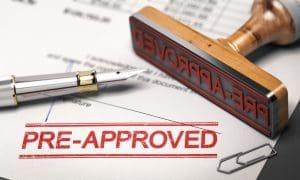So, you were recently getting pre-approved for a mortgage. Congratulations! But don’t pop the champagne until closing day and all the home loan documents are signed and recorded. Getting a pre-approved mortgage up-front can streamline your entire home buying process if you align yourself with the right lender and realtor.
Securing a mortgage pre-approval is a crucial initial step in the home-buying process that is often overlooked by many buyers.
Getting a pre-approved mortgage from a credible lender informs you, the homebuyer, about the amount of mortgage you are likely to qualify for and the interest rate you might receive. Homebuyers with a pre-approved mortgage are often seen as more serious candidates, making it easier for them to purchase a home since sellers tend to favor offers from pre-approved buyers over those who aren’t pre-approved.
How to Get a Pre-Approved Mortgage When Buying a Home
Purchasing a home is a significant financial decision, and one of the first steps in the home-buying process is getting pre-approved for a mortgage.
The mortgage pre-approval provides you with a clear understanding of how much home you can afford and sets the stage for a successful home purchase.
When thinking about purchasing a home, you might opt to get pre-qualified for a mortgage first to estimate how much you can borrow before diving into the mortgage application or pre-approval process.
Begin by providing some basic information about your loan needs and the home you wish to buy.
Your responses will enable us to connect you with a lender suited to assist you with the mortgage pre-qualification process.
In this comprehensive guide, we’ll walk you through the steps to get preapproved for a mortgage when buying a home.
1. Assess Your Financial Situation Before Applying
Before you start the pre-approval process, take a close look at your finances. Calculate your monthly income, expenses, and outstanding debts. Understanding your financial health is crucial when determining how much you can afford for a home before starting the mortgage approval process.
2. Check Your Credit Score Before Requesting a Mortgage Pre-Approval
Your credit score plays a pivotal role in the pre-approval process. Request your credit report from all three major credit bureaus (Experian, Equifax, and TransUnion) and review it for errors. A higher credit score can lead to better mortgage rates, terms and a quicker mortgage preapproval. If you are unaware of your credit scores you may have to consider a no credit home loan which typically carries a higher interest rate with additional restrictions and closing costs. Your credit score is an important part of the preapproval process.
3. Improve Your Credit Score
If your credit score is lower than desired, take steps to improve it. Pay down outstanding debts, correct any inaccuracies on your credit report, and ensure you pay all bills on time.
If you are pursuing a conventional mortgage, a minimum credit score of 620 is required. For a federally backed FHA loan, a score of at least 580 is necessary, accompanied by a 3.5 percent down payment. While VA loans and USDA loans do not have specific government-required minimum credit scores, lenders typically establish their own credit requirements. In general, a higher credit score can secure you a lower interest rate and more favorable mortgage terms from a lender.
4. Gather Financial Documentation to Get Pre-Approved
Lenders will require various financial documents to assess your eligibility for a home loan that equates to a mortgage preapproval.
These documents typically include:
- W-2 forms or tax returns for the past two years
- Recent pay stubs
- Bank statements
- Documentation of other assets
- Proof of any other sources of income
- Information on outstanding debts
5. Choose a Mortgage Lender that Offers Mortgage Pre Approvals
Research and select a mortgage lender that aligns with your financial needs and goals. You can choose from traditional banks, credit unions, or online lenders or brokers. It’s a good idea to to get preapproved for a mortgage and compare offers from different lenders to secure the best terms.
6. Get Pre-Qualified for a Home Loan
Pre-qualification is an informal estimate of how much you may be able to borrow based on your income, credit score, and other financial information. While pre-qualification for a home loan can provide a rough idea of your buying power, it’s not as strong as mortgage preapproval letter.
7. Pursue Mortgage Pre-Approval
Mortgage pre-approval is a more thorough process than pre-qualification. It involves submitting your financial documents to the lender for a comprehensive assessment. The lender will check your credit, verify your income, and assess your debt-to-income ratio.
8. Complete the Mortgage Application
To begin the pre-approval process, you’ll need to fill out a mortgage application. You can often do this online or in person, depending on the lender. The application requires detailed information about your finances, employment history, and the property you plan to purchase.
9. Provide Necessary Documents
Submit all the required documents as requested by your lender. This may include W-2s, tax returns, pay stubs, bank statements, and more. Be prompt in providing these documents to keep the preapproval process moving smoothly.
10. Review and Sign the Pre-Approval Mortgage Letter
– Once your lender has reviewed your application and documents, you will receive a pre-approval letter. This letter outlines the loan amount you are pre-approved for, the interest rate, and other terms. Review the mortgage preapproval letter carefully and, if you agree, sign and return it to the lender.
11. Real Estate Agent Engagement
– With your pre-approval letter in hand, you can engage a real estate agent to start shopping for a home. Your agent will use the pre-approval letter to help you find properties within your budget.
12. Shop for Your Dream Home:
– Work closely with your real estate agent to identify properties that match your criteria and budget. The pre-approval letter demonstrates to sellers that you are a serious buyer, which can be advantageous in competitive real estate markets.
13. Make an Offer
– Once you find a home you love, work with your real estate agent to submit an offer to the seller. The fact that you’re pre-approved can make your offer more attractive to sellers.
14. Finalize Your Mortgage
– After your offer is accepted, work closely with your lender to complete the mortgage application process. This includes tasks like an appraisal, a home inspection, and final underwriting.
15. Close the Deal
– After all conditions are met, you’ll attend the closing of your home purchase. At this stage, the mortgage documents are signed, and you officially become a homeowner.
The mortgage preapproval is a crucial step in the home-buying journey, as it helps you understand your budget, simplifies the shopping process, and makes your offer more appealing to sellers. Be sure to work with a trusted lender and a skilled real estate agent to navigate the home buying and preapproved for a mortgage smoothly.
Mortgage Pre-Qualification Versus Mortgage Preapproval
The terms “pre-qualification” and “pre-approval” are often used interchangeably, but they represent distinct processes. In a mortgage pre-qualification, you offer a general overview of your finances, income, and debts to a mortgage lender, who then provides an estimated loan amount.
While a mortgage pre-qualification can serve as a useful estimate of your home affordability, it lacks the verification of your financial details or a credit report check. Consequently, it acts as a preliminary assessment to determine your potential budget but does not carry weight in the context of making offers.
Conversely, a mortgage pre-approval entails completing a home loan application and furnishing your Social Security number for a hard credit check by the lender. A hard credit check is triggered when applying for a mortgage, involving the lender pulling your credit report and score to evaluate your creditworthiness. These checks are recorded on your credit report and can impact your credit score.
Distinct from this, a soft credit check occurs when you check your credit on your own or when a credit card company or lender pre-approves you without your request, with no impact on your credit score.
During the pre-approved mortgage process, you provide comprehensive details such as bank account information, assets, debts, income, employment history, past addresses, and more. This thorough process is aimed at ensuring your ability to repay the loan. The information gathered is also used to calculate your Debt-to-Income (DTI) ratio and Loan-to-Value (LTV) ratio, crucial factors in determining the interest rate and the optimal loan type.
Shop for the Best Rates When Getting a Mortgage Preapproval
Rates and terms can vary significantly among lenders, so it’s advisable to obtain quotes from multiple banks, credit unions, and online lenders before seeking mortgage preapproval. Many mortgage lenders offer the option to check interest rates online without impacting your credit score.
For accurate comparisons, look at the annual percentage rates (APRs) provided by lenders. Unlike simple interest rates, APRs include any fees, giving you a clearer picture of the overall cost of the loan. Also consider the following factors:
Whether the mortgage interest rate is fixed (unchanging for the loan’s duration) or adjustable (subject to change, potentially affecting monthly payments).
- The term of the loan, which determines how long you have to repay.
- The amount required for a down payment.
- Whether purchasing mortgage points to lower your interest rate is necessary.
- The duration your rate is locked in and if there is an option to “float down” to a lower APR if one becomes available before you close on the loan.
7 Things to Kill Your Mortgage Pre-Approval Online

Despite what you might hear, there are plenty of things you can do to kill your mortgage preapproval before closing day.
1. The Home Loan Commitment
You might not have heard about this one, but it is important.
Since the housing crash, there have been many changes in loan regulations and the accompanying documents.
You should carefully review your loan commitment, so you are aware of any conditions for final approval of the mortgage.
For example, you may need to provide more information about gaps in your income history, an explanation for where the down payment came from and your final salary numbers for last year.
These might seem like pesky details, but federal regulators have really cracked down on lending practices in the last several years.
The government wants to be certain lenders are really verifying that people can pay their mortgage loans. The last crash happened because lenders were not carefully checking that people had the income to afford their mortgages.
2. Confusing Loan Approval Amount with What You Can Afford
If you get approved for a $300,000 mortgage, it does not really mean you can get a home for $300,000. The spending limit is probably less than that; your monthly payment will include a lot of extras, such as homeowner’s insurance, taxes, and private mortgage insurance.
It also is important to have an emergency fund to cover major repairs.
Whatever amount you have been approved for, it is a good idea to determine a monthly payment that you are comfortable with that is well below the maximum. That way you will not be financially stressed in the coming years as repairs and extra expenses come up. Choose the loan amount you can afford when getting preapproved for a mortgage.
3. Paper Trail Problems with Income
When you are buying a home, you probably are looking for extra cash wherever you can get it – from bonuses to help from your parents in some cases. But with the state of lending laws today, you want to be careful to have a good paper trail for every dollar that is not coming from your regular, monthly income. So, any cash deposits or checks that are not a part of your regular paychecks will need to be explained with paperwork.
If you get some help with your down payment from in laws, for example, this is generally ok, but you will need to have it documented that it is a gift and not a loan. This will be needed for the mortgage file.
4. Assuming It Will Be Easy as a Repeat Home Buyer
Whether you get your loan finally approved or not comes down to the underwriter decision. No matter who you are or how many times you have bought a home, the underwriter is required by law to evaluate your credit, capability, collateral and character.
Underwriters don’t, and can’t, make any allowances for repeat buyers, or for new buyers for that matter. Underwriting is closely regulated by federal law, and the number of homes you have bought before is not part of the equation.
5. Making Major Purchases
Until you have signed everything at the closing table and those documents have been recorded with the local government, the mortgage lender is largely in charge of your financial situation. So, you should not make major purchases on credit cards, nor should you go out and buy a $100,000 yacht on credit. Anything that will lower your credit score and affect your debt to income ratios is not something you want to do until the loan is really done. The lender is required to recheck your credit right before closing, so make sure nothing has changed on your credit report.
6. Paying Bills Late
You would be surprised probably, but more than a few people get a mortgage pre-approval and then slip up and pay bills late. If you get any black marks on your credit report before you close the loan, that could derail the entire deal eliminate the ability t get preapproved for a mortgage. Consider a rent to own home program if you can’t qualify for a traditional home loan.
7. Getting New Credit
When you have your pre-approval, now is NOT the time to go get new credit cards or a car loan. Let it wait until the loan is final and you have moved into your new home. Also, every time you apply for credit, it lowers your credit score. That is the last thing you want when you are getting a mortgage.
Is Your Credit Score Affected When You Get a Pre-Approved Mortgage?
Obtaining a mortgage preapproval may lead to a brief decline in your credit score. The act of securing pre-approval for a home loan is categorized as a hard inquiry. FICO advises that consolidating hard credit inquiries within a 30-day timeframe helps mitigate the impact on your score.
Takeaways on Getting Mortgage Preapproval Today
In many instances, you can secure a mortgage preapproval by completing an online application and, if needed, discussing further details with a lender over the phone. If you prefer a more personal interaction, you typically have the option to meet with a lender at a local bank branch.
Regardless of your preferred method for obtaining preapproval, be sure to get organized to prepare yourself to get your offer accepted.
The process for getting a pre-approved mortgage is straightforward, and most banks, broker and lenders provide pre-approval letters to eligible applicants.
Mortgage pre-approvals typically have a validity period ranging from 30 to 90 days, during which you can decide to formally proceed with the mortgage application.
It’s important to note that pre-approvals are not binding loan agreements. Once your offer on a house is accepted, you must complete a formal mortgage application with your chosen lender to move forward.
Securing a mortgage pre-approval is a valuable initial stride when embarking on the path to homeownership. After thorough verification of your financial details, you’ll gain a precise understanding of your affordable home range.
To secure preapproval, you must compile documentation, such as Social Security numbers, proof of income, banking details, and tax forms. (Refer to a pre-approved mortgage documentation checklist.)
Before applying, it’s advisable to organize your finances. This may involve rectifying inaccuracies on your credit report or settling existing debts to demonstrate to lenders your capacity to afford a mortgage.
Home loan pre-qualification provides a more relaxed and informal assessment of your home-buying readiness, whereas preapproval is a more comprehensive process suited for motivated buyers ready to make a purchase.
It’s important to note that your mortgage preapproval is likely to expire within three months or even sooner.
Obtaining mortgage pre-approval before commencing your house search proves advantageous for all parties engaged in the process. If you make sure that you do not do any of the above mistakes when you are getting your mortgage, the chances of getting final approval and the keys to the front door are much higher!

